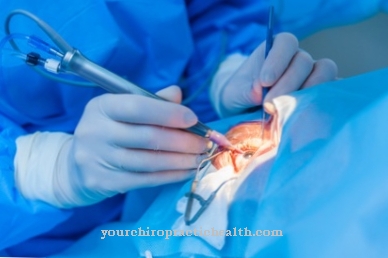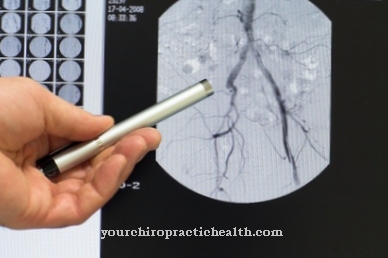As Vascular prosthesis This is an implant that replaces natural blood vessels. It is mainly used for chronic vasoconstriction, bypass operations or for severe vasodilatation.
What is a vascular prosthesis?

A vascular prosthesis replaces natural blood vessels and is used when there is severe damage to an artery. In this case, the blood flow can no longer be established with the help of a stent. During an operation, narrowed blood vessels are exchanged or enlarged blood vessels are replaced.
A prosthesis is also used for vascular injuries, such as after accidents. In the middle of the 19th century the first attempts at arterial replacement were made, with attempts being made to implant tubes made of rubber, silver or glass. However, these attempts failed because the implants closed thrombotically.
In the second half of the 19th century Guthrie and Carrell researched this area and carried out experiments with alloplastic, autologous, and heterologous replacements. For this, Carrell received the Nobel Prize in 1912. The breakthrough came with the Americans Jaretzki, Blakemere and Voorhees, who implanted plastic tubes for the first time.
Function, effect & goals
Vascular prostheses are used for a wide variety of vascular diseases. These include:
- Atherosclerosis with occlusions and constrictions
- Coronary heart disease
- Arterial occlusive disease of the leg and pelvic arteries
- Narrowing of the carotid artery
- Constriction of the viscera and renal arteries
Vascular prostheses are usually made of plastic, such as polytetrafluoroethylene (PTFE) or polyethylene terephthalate (PET). PET prostheses are mainly used for the aorta, the femoral arteries and the inner and outer pelvic arteries. These prostheses have a folded structure, which ensures great flexibility. PTFE prostheses, on the other hand, are used for bypass operations and for smaller vessels. The prostheses are coated with a protein layer made of collagen, gelatine or albumin, the inside is lined with fibrin and blood platelets due to the blood flow.
To produce vascular prostheses, the plastic is melted and processed into yarn. Tubes are then knitted or woven from this. These two prostheses have the advantage that they can be implanted directly without having to preclott them beforehand. For a preclotting, blood is drawn and the prosthesis is soaked inside and outside with blood. The surgeon has to stretch the prosthesis several times so that the cavities are also wetted. There are also autologous transplants, which means that the body's own arteries or veins are used as vascular substitutes. Bioprostheses are made from heterologous or homologous vessels, and cadaveric veins or arteries are often used as homologous vessels.
This also includes the Dardik prosthesis made from umbilical cord veins. Heterologous vessels are vessels from animals such as pigs or cattle. Vascular prostheses are used either as a surrounding or bridging graft, whereby the choice of prosthesis depends on the intraluminal pressure, the vascular caliber and the course of the graft. The selection of a suitable vascular prosthesis is very important, as a prosthesis with the wrong dimensions can obscure vascular branches or shift. A vascular prosthesis is usually inserted with a catheter and then hugs the vessel wall, where it keeps the vessel open or reduces the blood pressure acting on the vessel walls.
As a rule, a vascular prosthesis is tubular and consists of a wire mesh that is covered with textile fabric or plastic. For very special areas of application there are also branched prostheses, which are called Y-prostheses and are used, for example, for an abdominal aneurysm. The prostheses can be in one piece or they can be composed of individual modules.
You can find your medication here
➔ Medicines for painRisks, side effects & dangers
About 90 percent of the prostheses still work five to ten years after implantation. In the case of prostheses that are only about six to eight millimeters in diameter, the chance of success after five years is less than 50 percent. The most common complications that can occur are blockages due to excessive tissue formation, problems with the material or the development of aneurysms or pseudoaneurysms.
In contrast to a stent, vascular prostheses are artificially implanted. This increases the incidence of infections, so regular wound checks during the first two weeks and afterwards with every physical examination are of great importance. It is also recommended that you take a platelet aggregation inhibitor every day after an implantation. The highest infection rate occurs with a larger bypass, but people are also at risk after an operation in the groin area. On the other hand, the risk of inflammation is very low in patients who have had an operation on the main artery.
The infections are mainly caused by staphylococci. These get onto the prosthesis, for example, when the implant comes into contact with the body surface during the operation. Bacterial colonization is also possible through tissue damage in the area of the prosthesis, for example if it rubs against the intestine. The bacteria then cover themselves with a mucous capsule so that antibiotics cannot work. However, the rate of infection can be reduced if the patient is given antibiotics before or during the operation.
If a vascular prosthesis is inflamed, the infected material has to be removed, then the wound is cleaned and a new prosthesis is inserted. There is also the option of implanting a special prosthesis. These prostheses are coated with silver and can also be soaked with antibiotics. This is a good way to ward off infections.












.jpg)



.jpg)










.jpg)
